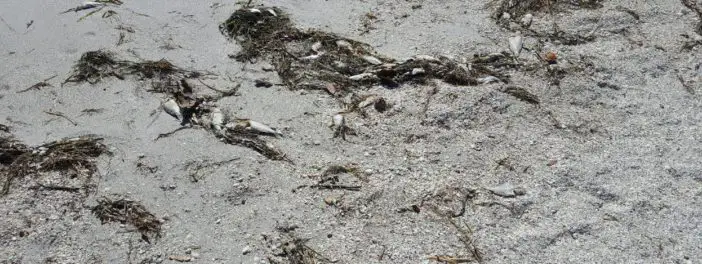
Red Tide Confirmed In Southwest Florida
- September 28, 2016
Red Tide Coming To St. Pete Beach
Red Tide impact coming into our area from the south and off shore. Individual precautions are advised for people susceptible to the health indicators of the algae which you can read about below. The Department of Health is responsible for the decision to close beaches and we will be reaching out to them for updates throughout the week. For now, the beaches are open but swimmers should be informed and aware.
What is Red Tide?
Red Tide is a naturally occurring microscopic algae that has been documented along Florida’s Gulf Coast since the 1840’s and occurs every year. Blooms, or higher-than-normal concentrations, of the Florida red tide alga, Karenia brevis , frequently occur in the Gulf of Mexico at this time of year (late summer or early fall). Red Tide begins in the Gulf of Mexico 10 to 40 miles offshore and can be transported inshore by winds and currents.
Although there is no direct link between nutrients related to human activity (for example, sewage and runoff) and the initiation of blooms, once blooms are transported inshore, these nutrient sources can fuel them. Karenia brevis produces neurotoxins called brevetoxins that can sicken or kill fish, seabirds, turtles, and marine mammals. Although less common, blooms of K. brevis can also contribute to fish kills by depleting the water of dissolved oxygen. Toxins can also affect humans, causing respiratory irritation if aerosolized toxins are inhaled or shellfish poisoning if shellfish contaminated with toxins are consumed.
Is There Red Tide On St. Pete Beach?
Researches at the Florida Fish and Wildlife Conservation Commission (FWC) are currently working with other partners to monitor a bloom currently localized in Southwest Florida.
FWC has documented several reports of fish kills in parts of Pinellas, Manatee and Sarasota counties. Water samples collected on September 19th and 20th, in response to fish kill reports, showed the first “high” cell concentrations of K. brevis since April.
The FWC currently has staff out in the field collecting water samples and investigating reports of fish kills. Since September 14, 2016 FWC researched have processed over 150 water samples from Southwest Florida and are continuously working to track these red tide blooms.
Seafood Safety
Shellfish, including clams, oysters, and mussels can accumulate brevetoxins. Brevetoxins have no taste, smell, or color, and can’t be destroyed by cooking. If contaminated shellfish are eaten, people can become ill with Neurotoxic Shellfish Poisoning (NSP). Shellfish harvesting from regulated areas is banned during blooms of K. brevis. Fish are safe to eat as long as they are caught alive and only the muscle is eaten. The muscle of crustaceans, including crab, shrimp, and lobster, is not affected by red tide toxins and can be eaten.
Health Hazards to Humans
Symptoms of NSP include abdominal pain; nausea; vomiting; diarrhea; reversal of hot/cold sensations; progressive sensations of tingling, pricking, or burning; lack of muscle control during voluntary movements; muscle pain; headache; and vertigo. In severe cases, an abnormally slowed heart rate may occur. The duration of NSP, which varies from person to person, typically lasts 3 days. Respiratory irritation associated with blooms of K. brevis is usually temporary, but serious illness can occur in people with asthma, COPD, or other respiratory diseases. Some people who swim in red tide experience skin irritation and rashes, and some swimmers have reported eye irritation from the sea foam.





